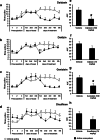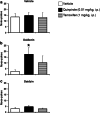Daidzein modulates cocaine-reinforcing effects and cue-induced cocaine reinstatement in CD-1 male mice
- PMID: 33839903
- PMCID: PMC8233246
- DOI: 10.1007/s00213-021-05820-z
Daidzein modulates cocaine-reinforcing effects and cue-induced cocaine reinstatement in CD-1 male mice
Abstract
Rationale: Cocaine addiction is a chronic relapsing disorder that lacks of an effective treatment. Isoflavones are a family of compounds present in different plants and vegetables like soybeans that share a common chemical structure. Previous studies have described that synthetic derivatives from the natural isoflavone daidzin can modulate cocaine addiction, by a mechanism suggested to involve aldehyde-dehydrogenase (ALDH) activities.
Objectives: Based on these previous studies, we investigated the effects of three natural isoflavones, daidzin, daidzein, and genistein, on the modulation of the cocaine reinforcing effects and on cue-induced reinstatement in an operant mouse model of cocaine self-administration.
Results: Chronic treatment with daidzein or genistein decreased operant responding to obtain cocaine intravenous infusions. On the other hand, daidzein and daidzin, but not genistein, were effective in decreasing cue-induced cocaine reinstatement. Complementary studies revealed that daidzein effects on cocaine reinforcement were mediated through a mechanism that involved dopamine type-2/3 receptors (DA-D2/3) activities.
Conclusions: Our results suggest that these natural compounds alone or in combination can be a potential therapeutic approach for cocaine addiction. Further clinical studies are required in order to ascertain their potential therapeutic use.
Keywords: cocaine; daidzein; daidzin; dopamine receptors; genistein; isoflavones; reinforcing; reinstatement; self-administration.
Conflict of interest statement
On behalf of all authors, the corresponding author states that there is no conflict of interest.
Figures





References
-
- Arolfo MP, Overstreet DH, Yao L, Fan P, Lawrence AJ, Tao G, Keung WM, Vallee BL, Olive MF, Gass JT, Rubin E, Anni H, Hodge CW, Besheer J, Zablocki J, Leung K, Blackburn BK, Lange LG, Diamond I. Suppression of heavy drinking and alcohol seeking by a selective ALDH-2 inhibitor. Alcohol Clin Exp Res. 2009;33:1935–1944. doi: 10.1111/j.1530-0277.2009.01031.x. - DOI - PMC - PubMed
MeSH terms
Substances
Grants and funding
LinkOut - more resources
Full Text Sources
Other Literature Sources
Medical

